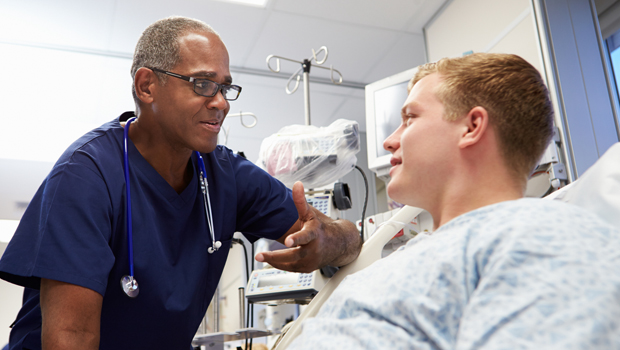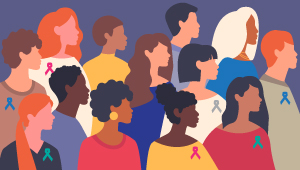Study sheds light on needs of young people with cancer

Understanding emergency department use among adolescent and young adult cancer survivors can help address care gaps
Emergency department use was common for adolescent and young adult cancer survivors within 5 years of a cancer diagnosis, and differences in use were associated with social and demographic factors and cancer type, according to a new study from Kaiser Permanente.
The American Cancer Society reports that more young people are being diagnosed with cancer. Understanding their survivorship needs is important for providing the best care. The study, published in the Journal of Adolescent and Young Adult Oncology, provides some of the most comprehensive information to date for identifying potential care gaps in this population, looking at use of the emergency department as an indicator. The research helps identify areas where health systems could focus to optimize care and meet the unique needs of adolescents and young adults after cancer treatment. The study was led by researchers with Kaiser Permanente Washington Health Research Institute (KPWHRI) and Kaiser Permanente Southern California Department of Research & Evaluation.
The researchers found that emergency department visits were common for adolescent and young adult patients who received a cancer diagnosis 2 to 5 years earlier. Nearly 40% of the study population visited the emergency room at least once during that time period, but the rates of use declined as time from diagnosis elapsed. Rates of use were higher for those who had public insurance and were between 20 and 24 years old, female, and Black. Colorectal cancer and cervical cancer diagnoses were also associated with higher rates of emergency department use compared with other cancer diagnoses.
Visits to the emergency department are significant because they can indicate when someone is experiencing secondary effects of cancer treatment, mental health challenges, or other health concerns that could be related to their cancer diagnosis. Regular emergency room visits might also mean that a patient doesn’t have a primary care doctor or isn’t seeing them regularly or is not having follow-up with their oncology doctor.
“Emergency department use for non-urgent conditions often has detrimental impacts for both the patient and the health care system,” said Thearis Osuji, MPH, coauthor on the paper and a senior scientific program manager at the Department of Research & Evaluation. “For example, someone who goes to the emergency room might have challenges accessing routine primary care, so they may receive unnecessary testing and treatment because they are being seen by someone who is not very familiar with their care.”
Differences in use
The researchers looked at rates of emergency department use for nearly 8,000 Kaiser Permanente California members ages 15 to 39 who received a cancer diagnosis in the last 2 to 5 years. The study included patients diagnosed from 2006 to 2020 and used data from Kaiser Permanente’s cancer registry and electronic health record.
The study found that headaches, acute urinary tract infections, chest pressure, and sepsis were consistently in the top 10 reasons why adolescent and young adult cancer survivors visited the emergency room. Social and demographic factors, such as race, ethnicity, and type of insurance, were associated with disparities in the number of visits, even among patients who had a primary care doctor.
Rates of emergency department use were also higher for certain cancer types in the study. Survivors diagnosed with leukemia, breast cancer, sarcoma, cervical cancer, and colorectal cancer had a higher rate of visits. When the researchers looked only at people who were no longer actively receiving cancer treatment, the rate of use remained high for those with a cervical or colorectal cancer diagnosis.
“Our results suggest that young cancer survivors may need more support or coordination after their treatment ends, even those with access to health care through insurance and robust provider networks,” said Erin Hahn, PhD, MPH, senior author on the paper and a research investigator at the Department of Research & Evaluation. “A more coordinated approach to providing care could affect long-term cancer outcomes.”
Assessing social needs for better care
The study findings related to social and demographic factors were consistent with previous results from a national study of cancer survivors that was not limited by age. The earlier research found that participants who were Black, lower income, female, and lacked health insurance had elevated rates of emergency department use, possibly driven by an association between those factors and worse late effects after cancer treatment (side effects that appear months or years after treatment).
Kaiser Permanente conducts a national social needs assessment for members, which the researchers said could help optimize care for adolescent and young adult cancer survivors.
The researchers also looked at rates of suicide attempts in the study group. Overall, suicide attempts were rare, but the rate was 3 times higher than among people of the same age group in the general U.S. population. They wrote that mental health care remains an enduring need for adolescent and young adult survivors that should be incorporated into survivorship care.
Next steps
“These findings give us a roadmap for where to look more closely for potential opportunities for improving survivorship care,” said Karen Wernli, PhD, lead author of the paper and a senior investigator at KPWHRI. “Now that we know the big picture, we can start drilling down to figure out what barriers exist and which interventions might address them.”
Clinicians can also use the results to inform their communication with patients, the researchers said. For example, knowing that young people with cervical or colorectal cancer are more likely to visit the emergency room in the years after a diagnosis might prompt increased efforts to ensure patients are receiving appropriate follow-up care and screening, or improved communication with those patients about their symptoms or ongoing care.
This analysis is part of a large study looking at overall care utilization among adolescent and young adult cancer survivors. With data from Kaiser Permanente Northern California, Kaiser Permanente Southern California, the state of California, and the state of Utah, the researchers are planning to analyze use of outpatient care, rates of hospitalization, and more detailed patterns of emergency department use.
The study was funded by the National Cancer Institute.
Kaiser Permanente coauthors are Marlaine Figueroa Gray, PhD, and Jessica Chubak, PhD, of KPWHRI; Eric Haupt, ScM, and Ernest Shen, PhD, of Kaiser Permanente Southern California; and Lawrence Kushi, PhD, of Kaiser Permanente Northern California.
By Amelia Apfel
VOICE STUDY

Understanding young adults’ experiences with cancer
The VOICE study aims to improve the health and health care of people who had cancer as adolescents and young adults.
Research

Some adolescents are more likely to use patient portal than others
A new study aims to understand trends in digital care communication among teens.
Research

Improving cancer prevention and early detection
How KPWHRI is contributing to better cancer screening and better outcomes for patients.



